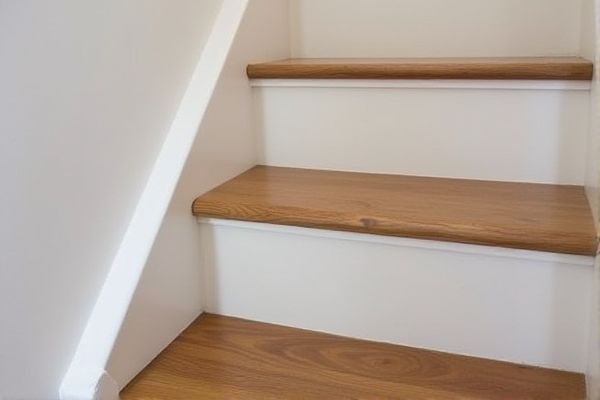
Stair nosing extends beyond the edge of a step, enhancing safety by providing extra grip and visibility, while flush treads align perfectly with the stair surface for a sleek, minimalist look. Discover which option best suits Your stair design and safety needs by reading the rest of the article.
Table of Comparison
| Feature | Stair Nosing | Flush Tread |
|---|---|---|
| Definition | Trim attached to stair tread front edge for protection and safety | Tread level with the stair landing or adjacent floor without protrusion |
| Safety | Enhances slip resistance and visibility; reduces fall risk | Sleek surface; may have less slip resistance without added texture |
| Durability | Protects tread edge from wear and damage | Uniform surface may show wear more quickly at edges |
| Aesthetics | Visible edge trim; can be decorative or contrasting | Minimalist, seamless appearance |
| Installation | Requires precise fitting of nosing strip | Needs accurate leveling to align tread flush |
| Common Materials | Aluminum, rubber, vinyl, wood | Wood, metal, stone, concrete |
| Applications | High-traffic stairs; commercial and residential for added safety | Modern design spaces; where flush surface aesthetics are prioritized |
Understanding Stair Nosing and Flush Tread
Stair nosing enhances safety by providing a visible edge and additional grip on each step, reducing slip hazards and wear on stair treads. Flush tread design offers a sleek, seamless appearance where the tread and riser align without protruding edges, ideal for modern aesthetics but may lack extra slip resistance. Understanding these differences helps in selecting the appropriate stair detail based on safety requirements, design preferences, and maintenance considerations.
Key Differences Between Stair Nosing and Flush Tread
Stair nosing protrudes beyond the edge of the stair tread, providing increased visibility, enhanced safety, and improved durability by protecting the stair edge from wear. Flush treads sit level with the stair stringer, creating a seamless, minimalist appearance but offering less edge protection and potentially reduced slip resistance. The choice between stair nosing and flush tread depends on safety requirements, aesthetic preferences, and maintenance considerations in stair design.
Aesthetic Appeal: Stair Nosing vs Flush Tread
Stair nosing offers enhanced aesthetic appeal by adding a defined edge that highlights each step, creating a striking visual contrast and depth. Flush treads provide a sleek, seamless look, ideal for minimalist or modern interior designs where smooth, uninterrupted surfaces are preferred. Choosing between stair nosing and flush tread depends on the desired balance between visual definition and subtlety in stair design.
Safety Considerations for Each Option
Stair nosing enhances traction and visibility on steps, reducing the risk of slips and falls by providing a defined edge and extra grip, especially in high-traffic areas. Flush treads create a seamless look but may lack the textured edge that helps prevent accidents, requiring careful material choice and maintenance to ensure safety. Your decision should balance aesthetic preferences with the need for secure footing to protect everyone using the stairs.
Durability and Longevity Comparison
Stair nosing offers enhanced durability by protecting stair edges from wear and impact, extending the lifespan of each step significantly compared to flush treads. Flush treads, while providing a sleek and seamless look, can be more susceptible to chipping and damage over time, especially in high-traffic areas. Choosing stair nosing ensures your stairs maintain structural integrity and safety longer, reducing maintenance needs and replacement costs.
Installation Methods: Stair Nosing vs Flush Tread
Stair nosing installation involves securely attaching a distinct edge profile to the stair tread using adhesive, screws, or clips, enhancing safety and durability by providing slip resistance and edge protection. Flush tread installation requires embedding the tread material seamlessly into the stair structure, often using precise cutting and adhesive bonding to create a level surface without protruding edges. Both methods demand meticulous measurement and surface preparation, with stair nosing offering easier retrofit options and flush treads requiring more complex, often new construction processes.
Maintenance and Cleaning Requirements
Stair nosing requires more frequent maintenance and cleaning due to its protruding design, which can trap dirt and debris along the edges, increasing wear and tear. Flush treads, being level with the staircase surface, allow for easier cleaning with fewer crevices to accumulate dust, resulting in lower overall maintenance efforts. Choosing flush treads improves hygiene and reduces the time and cost associated with regular upkeep in high-traffic areas.
Cost Analysis: Which is More Economical?
Stair nosing generally offers a more economical option compared to flush tread due to lower material and installation costs, with prices often ranging from $5 to $15 per linear foot versus flush tread's $20 to $50 per tread. Maintenance expenses also favor stair nosing, as its durable profiles reduce the need for frequent repairs or replacements, enhancing long-term savings. Your choice should consider project budget constraints while weighing the initial investment against potential lifecycle costs.
Best Use Cases for Stair Nosing and Flush Tread
Stair nosing is best used in high-traffic areas where enhanced safety and durability are critical, such as commercial buildings and public spaces, as it provides increased traction and visibility on stair edges. Flush tread is ideal for residential settings or minimalist interior designs where a sleek, seamless look is preferred, as it integrates smoothly with the stair surface without protruding elements. Choosing between stair nosing and flush tread depends on balancing safety requirements, aesthetic preferences, and the specific demands of the stair environment.
Choosing the Right Option for Your Stairs
Selecting the right stair nosing or flush tread depends on the durability, safety, and aesthetic requirements of your stairs. Stair nosing provides enhanced slip resistance and protects the edge from wear, making it ideal for high-traffic areas, while flush treads offer a sleek, seamless look suitable for modern interior designs. Evaluating your staircase's usage and style will ensure you choose the best option that combines safety and visual appeal for your space.
 homyna.com
homyna.com